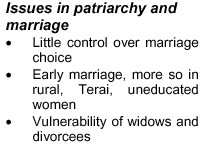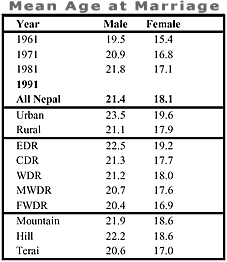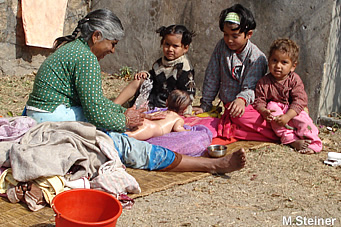|
Patriarchy
and Marriage
|
 |
 |
Across
the cultural diversity, the majority of communities in Nepal are patriarchal-a
woman's life is strongly influenced by her father and husband-as reflected
in the practice of patrilocal residence, patriarchal descent, and by inheritance
systems and family choice relations. Such patriarchal practices are further
reinforced by the legal system. Marriage has an overwhelming importance
woman's life. The event of marriage determines almost all her life options
and subsequent livelihood. |
 |
According to Hindu tradition, marriage is essential
for all, whether man or woman. While a man's life is not considered complete
without a wife, a woman has no option but to marry.
In
the Indo-Aryan culture, in particular, girls are encouraged to marry in
their early teens or even earlier by their parents. Early marriages are
rooted in both the concept of purity of the female body and the need for
helping hands in farm households in general. Marriage is a social contract
between two clans rather than the personal affair of the bride and groom.
Women and also men rarely have any role in the choice of their own life
partners. In addition, polygyny, though outlawed, can be still observed
especially in the rural areas of the Terai. In the Tibeto-Burman group,
there is far more flexibility in the choice of marriage partners. Nevertheless,
the majority of the population is dominated by patriarchal value systems
that accord overwhelming importance to early marriage and male children.
top
|
An
index of the degree of freedom
|
 |
 |
 |
Hence,
the overwhelming majority of both men and women are married before they
are 25 years old. In 1991, more than 86 percent of women and 61 percent
of men were married before that age. In the Indo-Aryan community, women
are tied for life by their marriage bonds. Hence, a woman's power to accept
or reject marriage partnership is evidently an index of the degree of freedom
she exercises in the management of her own life, and thus also of her status.
In the case of early marriage, the children concerned are too young to
comprehend the issues involved. By the time they understand the reality,
they are tied for life. An increase in the mean age of marriage, therefore,
may be taken as an indicator of increased power for individual women and
men in the cheice of their own life partners, and hence their empowerment.
In the non-Aryan communities, they may enjoy greater freedom of divorce
and remarriage, but they face the risk of being lett with young children
without assets or helping hands to provide for them. |
The
mean age of marriage for women in Nepal has increased significently from
15.4 years in 1961 to 18 years in 1991, indicating a slow but steady change
in secial peroeptions about the institution of child marriage . The change
is most pronounced for young girls. In 1991, 7.4 percent of fernales in
the 1-14 age group were reported to be married, compared with 24.9 pereent
in 1961.
top
|
Significant
differences in the mean age of marriage between rural and urban women
|
 |
There
are significant differences in the mean age of marriage between rural and
urban women, among women of various ecological zones, and between educated
and noneducated women. Urban women marry later than rural women do. From
an ecological zone perspective, a higher proportion of females is married
at an earlier age in the Terai than in the hills and mountains. In 1991,
more than 90 percent of the females in the Terai were married by the time
they had reachod the age of 24. The corresponding figures were notably
lower for the hills and mountains, standing at 82.4 percent and 83.6 percent,
respectively . The mean age of marriage varies also with level of education.
It is reported nearly four years' difference in the mean age of marriage
between girls with no education and those with secondary education.
top
|
Widowhood
and divorce
|
 |
 |
Early
widowhood with little possibility of remarriage, particularly in the Indo-Aryan
culture, is another curse upon women. More than 1.6 percent of the female
population-i.e. 7,000 women-were already widowed by 29 years of age in
1991. The risk of widowhood tends to increase with age. Only a small proportion
of women are divorced or separated in Nepal. However, this rate has shown
an increasing trend . Divorce rates also increase with age.
While
a higher proportion of divorced women rnay indicate the increased determination
of women to escape from oppressive marriages and situations of polygyny,
it may also indicate increasing abandonment by men. |
Even
taday, women who are divorcees are stigmatized in the Hindu tradition.
Thus, a divorced woman has litde chance of remarriage within her own sacicoconomic
greup if she comes from a high caste/class Hindu family. The need, from
the religious paint of view, to keep the clan blood pure is a paramount
factor in thus condemning women to single status for life or to a loss
of social status, if her first marriage fails.
| more information |
 |
 |
 |
External
Links |
|
Links
|
 |
 |
 |
External
Links |
 |

Maiti
Nepal
Against
traffiking |
 |
|












